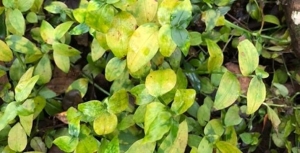Displaying items by tag: wandering trad
Trad fungus – a promising solution to rampant weed infestations
Tradescantia fluminensis, commonly known as wandering trad is one of the worst weeds in Sydney’s bushland and home gardens. This highly invasive weed rapidly takes over the ground layer in gullies and temporary watercourses, forming a thick blanket of leaves that excludes light and warmth. Trad aggressively smothers low plants and seedlings and cools the soil, preventing native plant germination and regeneration.
This plant spreads vegetatively, no seed is produced. Garden refuse dumped in bushland is a common form of spread. Stem fragments and roots readily wash down waterways or spread in mud from vehicles. Trying to remove trad is a very time-consuming process. Repeated follow up is required because a tiny stem or leaf left behind can regrow.
But now there is hope of a solution, a leaf-smut fungus called Kordyana brasiliensis. This agent was discovered on wandering trad during surveys in Brazil performed by researchers at the Universidade Federal de Viçosa. This exploratory research was part of the biocontrol program for this weed in New Zealand, led by Landcare Research.
After years of testing in Brazil, in New Zealand and in the CSIRO containment facility in Australia, researchers applied for approval to release the leaf smut fungus. They were granted approval by the Department of Agriculture and Water Resources in December 2018.
Researchers first released the leaf smut fungus at ‘nursery sites’ in the Dandenong Ranges during the cooler months of 2019. Nursery sites are areas where our staff will monitor the progress of the biocontrol agent to ensure it can survive and spread in the local area and is having a damaging effect on the wandering trad.
A new project from July 2020 to June 2023, co-funded by CSIRO and the NSW government through its Environmental Trust, is facilitating stakeholders’ releases of the fungus across the range of wandering trad in NSW. The project will also monitor the impact of the fungus on the weed and flow-on indirect impact on other vegetation at several sites during that period.
Ku-ring-gai Council is participating in the project and has released infected trad plants in several sites. It has been spreading rapidly in some sites such as the Gordon Flying Fox Reserve. The very damp conditions experienced over the past few months may be a factor. In other sites the spread has been fairly slow.
How it works
The leaf smut fungus (K. brasiliensis) spreads through spores, and it needs wandering trad leaves to survive. This pathogen enters wandering trad through the leave’s air holes (stomata), and slowly uses the weed’s energy for its own fungal growth. After two to three weeks, the leaves begin to develop yellow spots, caused by a lack of chlorophyll. Eventually the fungal infection is so severe that the wandering trad leaves die. The sick plant becomes less competitive against neighbouring native plants, giving them an advantage, and the opportunity to grow.
Don't worry, it's not another cane toad. It has been carefully tested by the CSIRO and only infects trad and not its close native relative Commelina which has blue flowers. The fungus needs the leaves of the wandering trad to survive – if there is no wandering trad to infect, the fungus dies.
Benefits of biocontrol agents
Biological control is the practice of managing a weed by deliberately using one or more of its natural enemies (biocontrol agents) to suppress it.
Specialised fungi, like the leaf smut, have specific genes that enable them to successfully infect and cause disease only on single or a narrow range of plant species. Testing involved looking at plants that are related to wandering trad including native plants to make sure the fungus will only infect the weed.
CSIRO field biologist Dr Ben Gooden, who is coordinating the rollout of the biocontrol program across Australia, said highly targeted and tested biocontrol agents like the fungus were a more environmentally sustainable option than other available tools. Scientifically tested biocontrol agents like this fungus provide a longer term, environmentally sustainable way of controlling weeds like wandering trad, without harming Australian plants or animals.
Thanks to the Facebook page of the Pittwater Natural Heritage Association and CSIROscope for some of this information.

